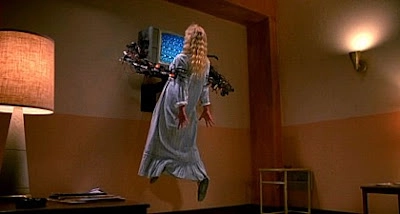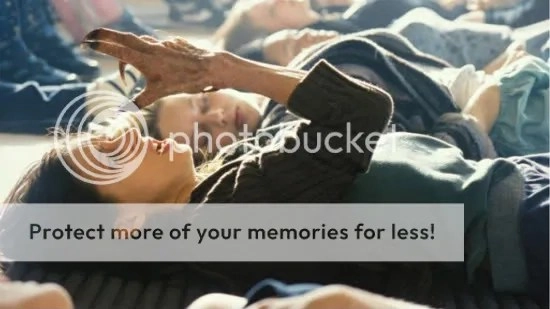The Fourth Wall
The Weekly Listicle: Julia’s Insane-Asylum-Flick Picks
Cinema has always been big on crazy people. Drama and comedy have portrayed the descent into instability and insanity, but I prefer to look at the way horror handles the subject. Film is of course a visual medium, and it’s troublesome to delve into the mental state of protagonists without physical representations. Enter the brutal fluorescent lights, the darkened rubber room, the dingy straight-jacket, the creepy inmate muttering incoherently to the wall as milky cataracts creep into her eyes. Asylums, especially in horror movies, are a visual representation of mental decline. My hopes are high for this theme in tomorrow’s Scorsese release Shutter Island, but until then, these are some of my favorite asylum-based horror movies.

Spiraling into madness: Session 9
SESSION 9 (2001)
Director Brad Anderson is fascinated with male guilt. 2004’s The Machinist, in which Christian Bale lost a reported 63 pounds (and was so emaciated as to be genuinely alarming onscreen), is about the physical manifestations of guilt. The episode of “Masters of Horror” Anderson directed (“Sounds Like”) also follows a man’s spiral into the crazy. Anderson’s 2001 creeper Session 9, also an examination of the toll guilt can take on a man, is one of the most genuinely spooky films I’ve ever seen. The movie was filmed at the abandoned Danvers State Hospital in Massachusetts, and features some of the eeriest sets in movies. The really scary part, though, is that it’s all real, from the foreboding, gabled red brick exteriors to the crematorium, to the eerily mosaic-tiled bathhouse, to the tiny isolation rooms. Unfortunately the Hospital was demolished a few years ago to make room for apartment houses, but there are dozens of websites dedicated to it and the many legends surrounding it (for instance, it may have been the inspiration for H.P. Lovecraft’s Arkham Sanitarium).
Enough about the hospital, though: Session 9 follows a group of workmen as they try to remove asbestos from the building. Each is affected differently by the asylum’s mysteries, and throughout the film we hear interview tapes of a patient with multiple personalities as she/he/they explain what happened the night her family was murdered. This all wraps up nicely when one of the workmen goes totally berserk. Murders and mutilations involve, among other things, the frontal lobotomy, which is one of the scariest and most grotesque “cures” for mental illness ever conceived. One of the characters also suffers from nichtophobia, or fear of the dark–something more people experience than admit, I think. The abandoned and decaying asylum forms a perfect metaphor for a mind slipping into insanity. Please watch this one by yourself in a darkened room with the sound turned up. You may regret it, but it’ll be unforgettable.

Television is bad for you: A Nightmare on Elm Street 3: Dream Warriors
A NIGHTMARE ON ELM STREET 3: DREAM WARRIORS (1987)
The third in the Nightmare on Elm Street series is my second favorite, behind the original and followed by the underrated–and oh-so-meta–Wes Craven’s New Nightmare. Nightmare 3: Dream Warriors brings back original protagonist Nancy (Heather Langenkamp) as an intern at a Springwood, Ohio mental hospital where a group of teenagers prepare to battle Freddy Krueger in their dreams. The patients in asylums aren’t always the crazy ones, and Nightmare 3 has fun with this. This pick is here mostly because it plays with a different aspect of insanity; in the Nightmare series, the kids aren’t alright–but it’s the parents who refuse to believe them and treat them like nutballs. A young Patricia Arquette plays Kristen, admitted after refusing to sleep and slashing her wrists. The others include a wannabe-actress, a former heroin addict, and a handicapped nerd. All are experiencing horrific nightmares featuring Krueger at his very best and most ridiculous. This Nightmare is utterly campy, and its sheer ’80s-ness is wonderful and strange. The gore is duly enjoyable, too. In one of the most grotesque scenes in horror history, Freddy literally plays one of the kids as a puppet, ripping his tendons out through his skin and tugging him along like a marionette. In another scene, a mohawked, leather-clad bad-ass gets a lethal dose of her drug of choice, but only after her track marks open into tiny sucking mouths. It’s complete cheese at its best, and don’t miss a nurse named Max, played by Laurence Fishburne back when he still went by “Larry.”

Group therapy gone terribly wrong: Ginger Snaps 2: Unleashed
GINGER SNAPS 2: UNLEASHED (2004)
Here we have yet another sequel–what can I say? I’m a sucker for B-horror series. The horror genre is historically so misogynistic (often heavy on female nudity and victimization) that the Ginger Snaps movies are a breath of fresh air. Ginger Snaps (2000) makes blatant comparisons between puberty and lycanthropy. When you think about it, the metaphor is crystal clear: during puberty, hair sprouts from strange places, unexpected body parts start to grow, carnal desires seem to take over your life, and you change completely (physically, anyway). The tag line of the movie is, “They don’t call it The Curse for nothing.” Hello, werewolf.
The series plays with the idea of female desire as a monstrous, ugly thing, something to be subjugated and forgotten. At the start of Ginger Snaps 2: Unleashed, Brigitte, one half of the sister pair from the first movie, is injecting Wolfsbane to stave off her own transformation into a monster. After she ODs and ends up face-down in a snowbank, she’s brought to a rehab facility (not exactly an asylum, but close enough) for young women with addiction problems. On top of this, a horny male werewolf is stalking her from the shadows, waiting for a moment to pounce and mate. From beginning to end, not a single human male in the film has pure intentions either; there’s innuendo everywhere, from basically innocent to completely lecherous. Brigitte, ever shameful of her sexual and animal desires, tries in vain to suppress what she’s becoming. Some of the film’s best scenes take place in the bowels of the rehab center and in group therapy (pictured above), so I figure it belongs here as much as any of the others do. I’m not going to say it’s a cinematic masterpiece by any means, but it sure is fun when you delve a little deeper than the ridiculous effects and slightly silly plot. If nothing else, it subverts the historical cliché of women as little more than jealous, catty, hysterical creatures. Women in these movies are strong, smart, and vulnerable, and not many horror films that can boast that.
Julia Rhodes graduated from Indiana University with a degree in Communication and Culture. She’s always been passionate about movies and media, and is particularly fond of horror and feminist film theory, but has a soft spot for teen romances and black comedies. She also loves animals and vegetarian cooking; who says horror geeks aren’t compassionate and gentle? Bank Routing Numbers





You must be logged in to post a comment Login